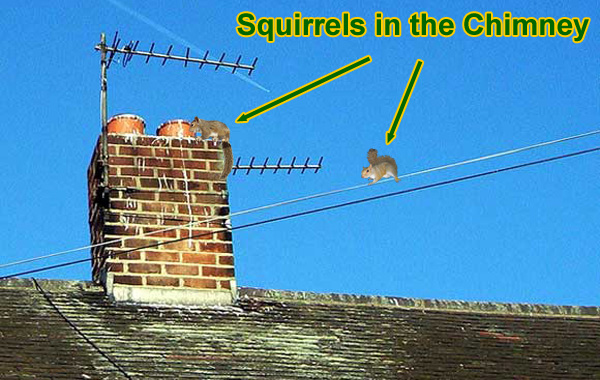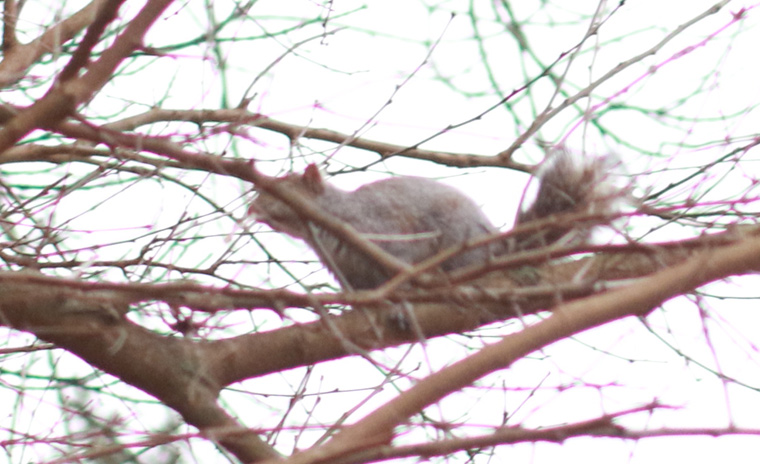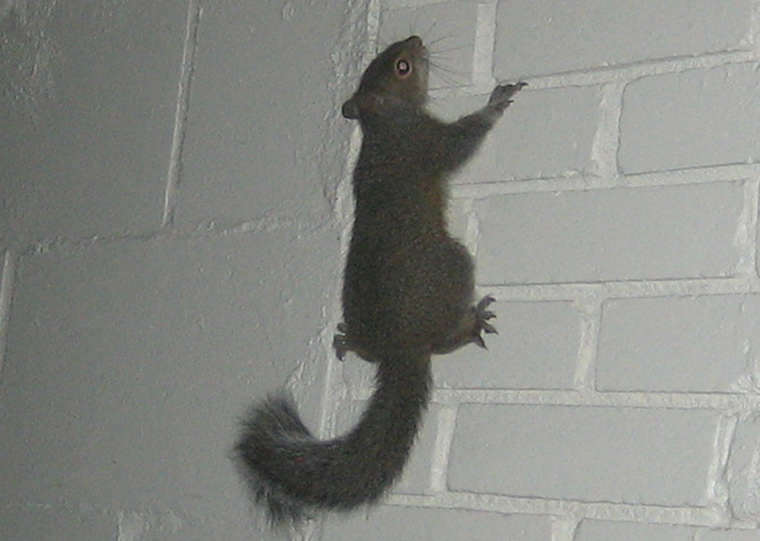- info@wildlife-removal.com
Call us for help in your town
Wildlife Removal Education
How To Get A Squirrel Out Of Chimney
Need squirrel removal in your hometown? We service over 500 USA locations! Click here to hire us in your town and check prices - updated for year 2020.
If it's a brick, stone, or mortar chimney, the squirrel will have no problem getting in and out, in which case you can trap or exclude the squirrel up
at the top of the flu. If it's a slick metal tube flu, then the squirrel can
get stuck in the bottom. In this case, you either have to let it out through the damper and into the fireplace, where you can nab it with a net or
even a blanket, or you can lower a thick rope down the flu for the squirrel to climb up and get out.
Do not, under any circumstances, start a fire. You may cook squirrels, baby squirrels, but the adult will jump out of the open damper into the house.
It is somewhat easy for a squirrel to get trapped in your chimney. Trapped in the manner that it can’t get out climb its way back out after falling through. The reason a squirrel may go into your chimney is because it is a small place where it can get protection from the weather outside. The problem with that is that it can be a lot more dangerous for the squirrel inside your chimney, than it would have been anywhere outside. Squirrels are one of the wildlife animals that are most likely to end up in your chimney because of their ability to climb. Once the squirrel is inside it is a great home because it is warm and dry. The squirrel may see the chimney as a hollow tree which is perfect for them to live in especially in the winter. The problem is that once a squirrel falls in, it can be difficult to get out depending on the walls inside the chimney.

Getting The Squirrel Out Yourself -
If the squirrel is in the chimney because it is trapped then the best thing you can do is to give it a way to get out. The easiest way to accomplish this is to use a rope. A rope has a surface that makes it easy for a squirrel to climb. Even a weak or injured squirrel may be able to climb it with relative ease. If the squirrel does not come out right away do not take the rope away. Remember that it may be scared or may be hesitant to come out with you there. Leave the rope there for a couple of hours and check again. More than likely the squirrel will be out by then. Do not try the “smoking it out” method; the squirrel may want to get out, but it may not be able to and that would just make matters worse.
Prevention -
If you have a chimney you should know that squirrels in the chimney are a common problem and you should stop the problem before it happens. There are chimney caps that help a homeowner keep squirrels and other types of wildlife out of the chimney. They are easy to install and are not expensive at all. The caps have spaces that let the smoke out, but those spaces are too small for any uninvited guest to get in. You should also keep an eye on the squirrels. The first sign that they are about to make it into your chimney is that you will see them just outside the chimney very early in the morning and sometimes at night. If you see that then it is time to get them out of there before one gets trapped and it is too late.
If These Methods Fail -
When removing wildlife, especially from a place like your chimney there are risks that a person performing the job is undertaking. You may run into difficulty with getting on the roof or you may have a hard time getting the squirrel to use any of your aids to escape the chimney. People who do this kind of work for a living will have techniques and equipment necessary to get the job done fast and without damage to your property. Squirrels are fast and though they may not be moving much if trapped in your chimney, the moment that they see an opportunity to get out they may do so quickly which can startle you. If you get startled while on the roof of your house it can lead to a serious injury and if you are nervous around wild animals it will be very easy to get startled. Weigh your options carefully and use all caution if you go onto the roof to remove the squirrel yourself.
Here are my other squirrel guides:
how to get squirrels out of the attic - for advanced tips and advice
squirrel removal page home page with basic information
squirrel trapping tips page, bait, trap types
squirrel repellent analysis of whether it works or not
how to kill squirrels should you use poison?
how to catch squirrels methods to catch them safely
how to keep away squirrels prevention techniques
signs you have squirrels in the attic best removal procedures
what to do when a squirrel gets inside your home guide to handling squirrels indoors
how to clean squirrel feces from the attic methods of removing squirrel poop
squirrels on the roof what to do if there's a squirrel on the roof
squirrels under the porch what to do if there's a squirrel under your porch
wildlife rehabilitators and squirrels what happens to squirrels next?
chipmunks chipmunk guide
Getting Squirrels Out the Chimney: The Easy Way
The title is a little misleading, because there isn’t a one-size-fits-all approach to keeping squirrels out of the chimney. The approach you take will very much depend on the kind of situation you're up against — whether the animal is stuck or able to get itself free, and whether or not the one squirrel is actually a mother with a family of little squirrels in tow, for example.

Let’s say that the animal is stuck …
A squirrel that has gotten itself stuck will need a helping hand unless you want it to die in there. If you leave the squirrel, it will more than likely die. The answer could be easier than you'd think though — in some cases, something as simple as dangling a length of rope from the top of the chimney to the bottom might do the trick. If the animal isn’t injured, it will use the rope as something to grab onto, running up the chimney and then off into the wild.
To speed things along a little, you could look at using some sort of repellent, but the only one that we can suggest for squirrels is wildlife eviction fluid. This fluid mimics the scent of predatory animals and is designed to “scare” the animal into leaving. Other repellents usually have little to no effect.
Let’s say that the animal is injured …
If the animal is injured, it won’t matter how many lengths of rope that you trail down into the chimney, the animal won’t be able to free itself without a little more help. In this case, you have a few options. The sensible (and quickest/most cost-effective) approach is to call in the professionals — wildlife rehabilitators. Same-day appointments are usually on offer, and the entire job could be finished in as little as a couple of hours, in many cases. Using rehabilitators also means that you don't have the job of working out what to do once you have grabbed the squirrel in your chimney, especially if it is injured.
Injured animals are scared animals. Scared animals are feisty and aggressive animals. There is a good chance that the squirrel will become very aggressive (translated into defensive, really) and attack you. It doesn’t know or understand that you are just trying to help it; it will assume that you are a predator, which, in theory, you are.
If you do want to take the hands-on approach, retrieving the animal yourself, we recommend using a snare pole style trap and make sure that you use it safely and properly. Gloved hands are necessary to prevent bites and scratches, and you must also take into consideration that there is a good chance you won’t be able to reach down to the spot the squirrel is stuck.
Let’s say that the animal is a mother with young in a nest …
You will need to take a very different approach if you have a mother squirrel in your chimney with a nest full of young squirrels hiding down there too. We definitely recommend calling in the professionals for this job, especially if you want to ensure that the small family has the best shot at survival when they are released back into the wild.
If the mother leaves her young, you can use that to your advantage. You might be able to retrieve her babies, using a snare pole, to place them in a trap. The entire package then works as bait for the mother — she will (hopefully) follow her family into the trap.
Sadly, life rarely goes as easy as all that.
Squirrels can be evicted using wildlife eviction fluid, and this is actually more so the case if you have a family — a mother with her babies. The smell of predators might just be enough to make the mother fearful. With any luck, she will move her young along to a safer nesting spot, leaving you then free to seal up the chimney and make sure they don’t come back.
You could try your hands at other repellents, but, as we have previously stated, they usually have little to no effect. They definitely do not work as a long-term solution, particularly if you want something cost-effective.
In all of these cases …
Once the animal has been removed, you MUST seal up the chimney space to ensure that no further animals can get in, fall in, or become trapped in that space. It is also smart to have a good look around your property, checking to see what might have attracted the animal in the first place. By removing the attractants — food, hiding spots, etc., — you will usually find that you have fewer wild critters in your back yard. If they’re not in your back yard, they're not checking out your attic. Either way, the attic, including the chimney, MUST be sealed and then kept that way.
Which Repellents Will Get Squirrels out of the Chimney?
Just a few moments hunting on the internet will provide you with a long list of repellents that are designed to get rid of squirrels. Here are a few common ones on the list:

- Hot/spicy foods, such as cayenne or chili peppers
- Zesty/citrus fruits, such as lemon or lime
- Ultrasonic sound devices
- Light machines
- Sprinklers/water systems
- Various essential oils, including peppermint and other menthols, eucalyptus, tea tree oil
- Mothballs
- Ammonia-soaked rags
- Sticky or gooey substances
- Strip spikes
- Poison
- Wildlife eviction fluid
Would you be surprised if we told you that we would actually only look seriously at ONE repellent on that list, for squirrels?
Some of them may have some effect, of course, but there’s a much higher chance that whatever you use will fail, or will just not prove to be a viable option for long-term usage.
Toxic substances and chemicals can actually make other animals sick, including pets, and using moth balls, ammonia, or poison is not a wise choice, especially if you have children in the area. The problem could even go as far as contamination of soil, water sources, or even food items.
One of the most important things that you must remember when relying on repellents to do the job of getting rid of a squirrel, is that the squirrel is free to do all the damage it likes to your home and property while the repellents aren't working. The more damage the squirrel causes, the more you will need to pay out to repair it. And still, after all of that, you still won't have solved the problem. Something will still be attracting these animals to your property, there are still holes that allow animals to gain access to your actual building, and the repellents have either not worked or just moved the animal along to a different spot, still on your property.
If you are going to rely on any repellent at all to get rid of squirrels from the chimney, we recommend using wildlife eviction fluid. This fluid is meant to scare squirrels away, although, more so with a female squirrel and her young in a nest. Made up of urine and other bodily secretions from wild animals (male, usually), the squirrel will hopefully believe that her young are under attack from a bigger predator. She won't stay and fight; she’ll move her young to a safer space. That's the theory, anyway, and sometimes it actually works.
We have seen various scenarios over the years of homeowners attempting to get rid of squirrels form the chimney using repellents. In many cases, the animal has died. The home or property owner may not be aware that a squirrel stuck in the chimney might just be that — stuck. It doesn't matter how many repellents you use, the squirrel is simply unable to get itself free.
Squirrels in the chimney are best tackled in this way > remove the squirrel(s), clean up the mess, repair the damage, and seal up the spot. Repellents don’t really play any role.
Go back to the Squirrel Removal page, or learn tips to do it yourself with my How to Get Rid of Squirrels guide.


















